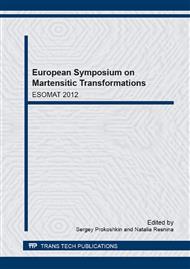p.247
p.252
p.257
p.262
p.269
p.274
p.276
p.281
p.287
Study of Nickel Segregation at the TiNi-Titanium Oxide Interface
Abstract:
Ab-intio investigations of atomic and molecular oxygen on TiNi(110) surface are performed by using the projector augmented wave method with generalized gradient approximation for the exchange-correlation functional. Our results confirm the formation of a Ni-rich interface TiO2(100)/TiNi(110), for which the formation energies (Hf) of point defects at the interfacial layers were estimated. It is shown that Hf of swap Ti-Ni defect has a lower energy than that for the Ni antisites at the interfacial layers. The formation energies of point defects in bulk TiNi, monoclinic TiO, and rutile TiO2 are also calculated. Our results demonstrate that Hf of Ni-antisites in TiO is twice less than that in TiO2. The formation of small Ni clusters is also discussed.
Info:
Periodical:
Pages:
269-273
Citation:
Online since:
January 2013
Authors:
Keywords:
Price:
Сopyright:
© 2013 Trans Tech Publications Ltd. All Rights Reserved
Share:
Citation:


